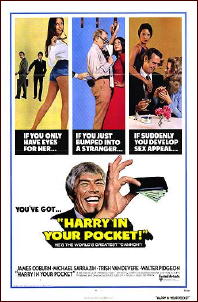July 2017
Monthly Archive
Fri 21 Jul 2017

THAT’S MY BABY. Republic Pictures, 1944. Richard Arlen, Ellen Drew, Leonid Kinskey, Minor Watson, Richard Bailey. Director: William Berke.
The setting for this definitively minor comedy effort from 1944 is supposed to be that of a comic book publisher’s office, which is why I rescued the DVD it’s available on from the $3 bin at a local record store. In truth, however — and the truth always comes out — Moody Productions looks more like an animated cartoon production facility, a supposition heavily reinforced by, well, the animated cartoon they produce on the quick that ends the movie.

It turns out that the head of the firm (Minor Watson) is suffering from a bad case of the blues, and to cheer him up, his daughter (Ellen Drew) and her beau (Richar Arlen) bring into his home a whole host of vaudeville acts, with no success. Not until they discover what it was in his past that has not allowed him to even smile in some twenty years.
This is a small time capsule of the kinds of acts that made people in small town America laugh. I don’t believe too many of these acts were ever preserved on film in many other ways. Many of these are pure corn, others are mildly amusing, and one, Gene Rodgers, the astoundingly good piano player, makes you wonder why you never heard of him before.
Mike Riley and His Musical Maniacs
Freddie Fisher and His Schnikelfritz Orchestra
Lita Baron, as Isabelita

The Guadalajara Trio
Gene Rodgers (boogie-woogie piano player)
Peppy and Peanuts
Mitchell & Lytell (office worker comedy routine)
Alphonse Bergé
Doris Duane
Adia Kuznetzoff (Russian singer)
Chuy Reyes and His Orchestra
Al Mardo and His Dog
Dewey ‘Pigmeat’ Markham
Personally, if you were to ask me, it is a wonder that both Richard Arlen and Ellen Drew, both consigned to B-movie stardom at the time, ever had careers after making a movie such at this, with one of the weakest storylines of any comedy musical I’ve ever seen.
Fri 21 Jul 2017
A 1001 MIDNIGHTS Review
by Bill Pronzini
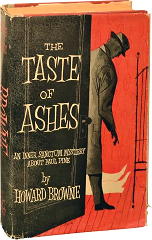
HOWARD BROWNE – The Taste of Ashes. Paul Pine #4. Simon & Schuster, hardcover, 1957. Dennis McMillan, trade paperback, 1988. TV adaptatation: Pilot episode of Bourbon Street Beat (ABC, 5 October 1959).
An early contributor to the Ziff-Davis line of pulps in the 1940s, Howard Browne later became managing editor of several of that Chicago-based publisher’s science-fiction and fantasy magazines. He also wrote extensively for radio and early TV, scripting more than 700 dramatic shows for the two media.
In 1946 he published his first mystery novel, Halo in Blood, under the pseudonym John Evans, and followed it with two more, Halo for Satan (1948) and Halo in Brass (1949); all three feature Chicago private detective Paul Pine, one of the best of the plethora of tough-guy heroes from that era. Although the Pine novels are solidly in the tradition of Raymond Chandler, they have a complexity and character all their own and are too well crafted to be mere imitations.
The Taste of Ashes is the fourth and (at least as of this writing) final Paul Pine adventure. Browne evidently chose to publish this one under his own name because it is longer, more tightly plotted, and more ambitious than the “Halo” books. Offbeat, violent, exciting, it is the story of Pine’s involvement with the lethal Delastone clan:
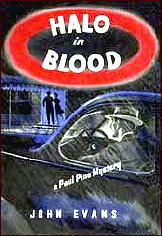
“… the Colonel, who wore his hair like the late William Jennings Bryan and was more afraid of scandal than of sudden death; Martha, a member of the sensible-shoe set; the lovely Karen, who owned a temper and a burglar tool; Edwin, who had gone to Heaven, or some place, leaving a monument of horror behind; and Deborah Ellen Frances Thronetree, age seven, an authority on the Bible and Captain Midnight, who was plagued by nightmares.”
A hood with the wonderful name of Arnie Algebra, a reporter called Ira Groat, and the haunted widow of another private eye are just three of the rich array of other characters Pine encounters on his violent professional (and personal) odyssey.
All three of the John Evans titles are also first-rate. Both Halo in Blood and Halo for Satan have highly unusual opening situations: In the former, Pine joins twelve other persons in the burial of a nameless bum; and in the latter, a Chicago bishop is offered a chance to buy a manuscript purportedly in the handwriting of Christ for the staggering sum of $25 million.
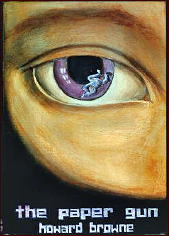
Browne is also the author, under his own name, of a nonseries novel, Thin Air (1954); the sudden, inexplicable disappearance of advertising executive Ames Coryell’s wife and his utilization of his ad agency and its methods to track her down form the basis for this tale of suspense. Thin Air has received considerable praise, but this reviewer finds it somewhat farfetched and Coryell a less than likable protagonist. Paul Pine is a much better character, and the private-eye novel the true showcase for Browne’s talents.
———
Reprinted with permission from 1001 Midnights, edited by Bill Pronzini & Marcia Muller and published by The Battered Silicon Dispatch Box, 2007. Copyright © 1986, 2007 by the Pronzini-Muller Family Trust.
Bibliographic Update: Published in 1985 by Dennis McMillan was the collection of Peter Pine stories entitled The Paper Gun, which included the unfinished and never before published title novel, plus the novelette “So Dark for April,” which previously appeared in Manhunt, February 1953, as by John Evans
Thu 20 Jul 2017
IT IS PURELY MY OPINION
Reviews by L. J. Roberts
C. J. BOX – Paradise Valley. Cassie Dewell #3. St. Martin’s Press, hardcover, July 2017.

First Sentence: “The trap is set and he’s on his way,†Cassie Dewell said to Sheriff Jon Kirkbride.
Inspector Cassie Dewell has been hunting the Lizard King, a serial killer of truck-stop prostitutes, runaways, and of her former boss. Now, she hopes she has set up the perfect lure to get him to come to her. She is also concerned about the disappearance of Kyle Westergaard, a young man with mild fetal-alcohol syndrome, and his friend Raheem.
Box does a very good job of explaining the details of things; lot lizards, the way in which independent truckers work, etc. At the same time, he does it without disrupting the flow or making one feel as though he has dumbed-down the information.
The characters are very well drawn and developed. The rest of the cast are people one would like to know, one has been unfortunate enough to know, and those one hopes never to know. Cassie and Wyatt, in particular, are wonderful characters.
There are villains, and then there are villains! From the very first book in which the Lizard King appeared, The Highway, it was clear Box had created one of the most frightening villains there is, partly because the type of crimes he commits are actually happening across our interstate highways. That said, one needn’t have read the first three books, as Box also does a good job of catch-up for new readers.
Box is always such a pleasure to read. He is a wonderful wordsmith with a very visual style who creates excellent analogies: “…driving an 18-wheeler was liking piloting a ship on the ocean. The captain of that ship had an entire blue-water sea in front of him and he could go anywhere on it.â€
In spite of this being his 24th book, plus some short stories, there’s no sign of them being formulaic or getting stale. Each is informative and very exciting. So much so that I often forget to make notes while reading
Paradise Valley is filled with excellent suspense, yet comes to a complete and satisfying ending.
The Cassie Dewell series —
1. The Highway (2013)
2. Badlands (2015)
3. Paradise Valley (2017)
Preceding these three books, as part of Box’s “Highway Quartet,” was Back of Beyond (2011).
Thu 20 Jul 2017
DAVID GERROLD “The Thing in the Back Yard.” First published in Fantasy & Science Fiction, Sept-Oct 2014. Collected in Entanglements and Terrors (DG Media, softcover, 2015).
For an author who’s been around for almost 50 years (I believe his firs published work was “Oracle for a White Rabbit,” which appeared in the December 1968 issue of Galaxy SF), why has it taken so long for me to have read anything he’s written? (I have seen the Tribbles episode he wrote for Star Trek, but then so has every SF fan in the world, at least those of a certain age.)
Better late than never, I say, and “The Thing in the Back Yard” begins in very familiar territory: Bob’s Big Boy restaurant in Toluca Lake CA, a true landmark of its kind. I’ve never stopped in, but I’ve passed by in a car many, many times. This is where the narrator of the story tells his friend Pesky Dan Goodman about the problem he’s been having with burglars getting into his home and stealing stuff.
Pesky Dan Goodman’s solution: hire a troll. Not a mere garden gnome, but a real life troll. Big mistake. Trolls grow, and the more you hate them, the more they grow. And the more territorial they get.
Pesky held up a hand to stop me. “Just meet him. Trust me on this.”
“Last time I trusted you, I nearly got my passport revoked –”
“Clerical error. You did get it straightened out, didn’t you?
“Only because my sister is on first-name terms with our congressman.”
“Well, there you are. No harm, no foul.”
“I don’t think you’re getting my point.”
“Sure I am. You need security. Emmett-Murray needs a quiet little corner. You won’t even know he’s there.
This falls into the category of Famous Last Words. This also is the funniest story I’ve read so far this year.
Wed 19 Jul 2017

VALERIE WOLZIEN – Murder at the PTA Luncheon. Susan Henshaw #1. St. Martin’s Press, hardcover, 1988. Fawcett Gold Medal, paperback, 1st printing, July 1990. TV movie: CBS, 4 December 1990, as Menu for Murder (with Julia Duffy as Susan Henshaw).
From the title you probably already know if there is a chance in the world you’ll read this one or not, but just in case, I’m here to tell you that the title really is all that you need to know. (The person who wrote the cover blurbs, front and rear, apparently never did read the book.)
To solve the case, two Connecticut state police troopers (one male, one female) engage the assistance of a local housewife to help them dig into the seamier side of suburbia. The emphasis is on personalities and motivation; the mechanics of the murder are all but ignored.
To add to this, while it’s not entirely unexpected, Wolzien does have a sitcom sense of humor about life in the country club set. So much so that if you’re not ready for it, the confusion it also produces can be awfully distracting. The third or fourth time our lead protagonist Susan Henshaw knocks over a glass of wine of a cup of coffee in the presence of the handsome young policeman from Hartford — and she’s supposed to be happily married — I was ready to heave a brick at the screen. Figuratively, of course. (Picture Susan St. James in the role.)
It does pick up from there, however.
— Reprinted from
Mystery*File #23,, July 1990. (slightly revised).
The Susan Henshaw series —
1. Murder at a PTA Luncheon (1988)
2. The Fortieth Birthday Body (1989)
3. We Wish You a Merry Murder (1991)
4. All Hallows’ Evil (1992)
5. An Old Faithful Murder (1992)
6. A Star-Spangled Murder (1993)
7. A Good Year For a Corpse (1994)
8. ‘Tis the Season to Be Murdered (1994)
9. Remodeled to Death (1995)
10. Elected For Death (1996)
11. Weddings Are Murder (1998)
12. The Student Body (1999)
13. Death at a Discount (2000)
14. An Anniversary to Die for (2002)
15. Death in a Beach Chair (2004)
16. Death in Duplicate (2005)
Tue 18 Jul 2017
REVIEWED BY DAVID VINEYARD:
ROBERT L. FISH – The Wager. Kek Huuygens #4. G. P. Putnam’s Sons, hardcover, 1974. Detective Book Club, hardcover, 3-in-1 edition. No paperback edition. Expanded from the short story “The Wager” appearing in Playboy, July 1973.

Though he is best remembered today for writing the book that the Steve McQueen movie Bullitt was based on under his Robert Pike pseudonym, Robert L. Fish in his day was one of the genre’s great success stories, author of the popular Captain Jose de Silva mysteries, the outrageous Schlock Homes parodies, and bestselling suspense novels such as Pursuit and The Gold of Troy.
For my money, though his best work were his tales of smuggler par excellence Dutchman Kek Huuygens (K Hi-gins is my best guess on pronunciation), a handsome and charming gentleman adventurer in the vein of Arsene Lupin. Huuygens stars in a collection of short stories and several novels, having made his debut in the latter form in The Hochman Miniatures.
The Wager opens with Kek living well in New York with his latest beautiful mistress Anita, involved in a low stakes game of Blackjack with a fellow member of the exclusive Quinleven Club in Manhattan. Watching the game on the side is one Victor Girard, a former dictator of the French-speaking Caribbean island of Ill Rocheaux, and only recently allowed in the country after being deposed and escaping narrowly.
The unpleasant Girard accompanied by his ever present gunmen bodyguards has a proposal for Kek, the wager of the title: He will bet fifty thousand dollars against Kek’s five thousand that Kek cannot smuggle a valuable Chinese artifact, “the Village Dance,†into the United States and deliver it to him.
Girard has already laid on a thief to steal the object from the museum in Ill Rocheaux, who will deliver the object to Kek for the next step in the operation. It seems almost simple, and Kek can resist anything but a challenge and an almost certain profit.
It isn’t simple, of course. There is an American named Ralph Jamison aboard Kek’s ship, and he is almost certainly a policeman of some sort, and the thief turns out to be Kek’s old friend André Martins, who has not succeeded in stealing the object and is in desperate trouble. Kek has no choice now but to steal the object himself.
To a book, the Kek Huuygens books are slender, fast-paced and intelligent reads with a charming protagonist who is a clever updating of the gentleman crook of yore. The writing is smart, the dialogue clever, and Huuygens one of the more attractive protagonists of his era. Better still there is no bad place to start in the series and they are all available in e-book form from Mysterious Press.
Fish makes it all look so easy, you may have to stop along the way just to recognize how effortlessly all the elements have been juggled into the perfect mix, the literary equivalent of one of those summer umbrella drinks served on a cruise.
The Kek Huuygens series —
The Hochmann Miniatures. NAL, 1967
Whirligig. World, 1970
The Tricks of the Trade, Putnam 1972
The Wager. Putnam, 1974
Kek Huuygens, Smuggler. Mysterious Press, 1976 (collection)
— Merry-Go-Round. Argosy, Nov 1964
— Counter Intelligence. Argosy, Sep 1965
— The Hochmann Miniatures, Argosy Mar 1966
— A Matter of Honor. MD, Win 1969
— The Wager. Playboy, Jul 1973
— A Collector.
— Sweet Music.
Tue 18 Jul 2017
Posted by Steve under
Reviews[2] Comments
REVIEWED BY BARRY GARDNER:
NEAL BARRETT, JR. – Dead Dog Blues. St. Martin’s, hardcover, 1994. Kensington, paperback, 1997.

Barrett is the author of “nearly 30” (28? 29?) mostly science fiction/fantasy books including The Hereafter Gang, which if you haven’t read by now, shame on you. His first mystery, Pink Vodka Blues, got good ink and is soon to be a Whoopi Goldberg/Ted Danson movie. Would I lie to you?
Jack Track (catchy, ain’t it?) is Town Marshal of tiny Pharaoh, Texas, returned there after a fourteen year absence during which bad and mysterious things happened to him. The book opens with a dead electric dog (who barks real loud) belonging to the town’s richest man, a real *sshole (in Jack’s opinion) who is pretty upset by the liberties taken with his dog, which was a Lab before it got dead and electrified.
Other characters include Jack’s current amour, Cecily the Yogurt Queen, Earl Murphy, the self-styled “N*gger of Wall Street,” who hasn’t built his house yet and sleeps in an Aston Martin Lagonda, and cast of tens. Then man follows dog.
The back cover calls Jack a private investigator and makes this sound like some sort of PI novel, but neither is true in the slightest. What it is, as usual with Barrett, is unclassifiable. Nobody does Bubba-talk like Barrett; nobody. If you don’t like the voice you’ll have a hard time liking the book.
It’s mostly a straight story, though he can’t resist tossing in several off-the-wall touches and characters, and it’s funny and serious both. That’s a hard line to walk, but for me, at least, Barrett is one of the few who can walk it.
Old Jack is an interesting, fairly realistic, and not altogether admirable character, and I’d like to see more of him. He’ll have to relocate, though — there aren’t enough people left in Pharaoh for another by the time this one’s over.
— Reprinted from Ah Sweet Mysteries #13, June 1994.
Editorial Comments: Barry’s review of Pink Vodka Blues appears here. In the comments following that review is a list of some of Barrett’s other work, including his science fiction, and some information about the screenplay for the never produced movie based on the book. The asterisks in this review are mine, not Barry’s.
Mon 17 Jul 2017

JESSICA JONES “AKA Ladies Night.” Marvel/Netflix. 10 October 2015 (Season 1, Episode 1). Krysten Ritter (Jessica Jones), Mike Colter (Luke Cage), Rachael Taylor (Trish Walker), Erin Moriarty, Eka Darville, Carrie-Anne Moss, David Tennant (Kilgrave). Created and written by Melssa Rosenberg. Based on the Marvel comic book character created by Brian Michael Bendis and Michael Gaydos. Director: SJ Clarkson.

To tell you the truth, I’ve already watched the first three episodes of this series, mostly since it took me a while to be sure I had a solid grip on the story line. The goal of a first episode of a TV series is to get viewers interested enough to be sure come back for the next one, but not necessarily to reveal all of their secrete at once, especially if there is a long connected story line, and not just a bunch of one-off episodes.
Maybe it’s me, and I haven’t adjusted to a new type of storytelling, but I think the producers of this series may have erred in not telling enough, or (perhaps) telling it too subtly. It could also be that they expected viewers to be more familiar with the characters from their background in comic books than I think they are. (It’s certainly not one of Marvel’s best known titles.)
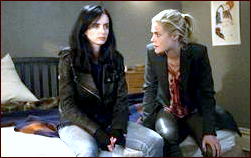
Jessica Jones, currently a private eye working on her own, is a flawed character, there’s no doubt about that. Something has happened in her past that makes it difficult for her to sleep at night, and worse, requires her to have a bottle or a flask of whiskey within arm’s reach whenever she’s awake. The first episode is designed to get us intrigued into learning more about what’s tormenting her, but it did take me all three episodes before I decided that, yes, I finally was sure was the overall story is about and the possible ways it could be going.

I’ll get back to that. In this first episode she’s hired by a man and woman from Omaha, Nebraska, to find their daughter, who has dropped out of school and has gone missing. I don’t want to spoil anything to anyone who would like to see the show and hasn’t yet, but I will have to leave some hints, such as saying the same thing has happened to the missing girl that happened to Jessica, only in Jessica’s case, the consequences were so bad that that is the reason she is in the severe funk she is in.
Another hint. The ending of this first episode makes it emphatically clear how bad the situation is for the missing girl — in a word, horrific — and if so, how bad was the experience for Jessica?

Other characters in the story are brought in, including a sexual dalliance between Jessica and the black owner of a bar. I don’t believe his name comes up, but he will be important in episodes to come. The female lawyer who often hires Jessica to do jobs other PI’s can’t do is having a lesbian affair with one of her staff while she already has a full-time relationship with another. A talk show host named Trish seems to be (or have been) very close to Jessica, but if it was stated what the relationship is, I still didn’t catch it after three episodes.

The other thing that is shown is that Jessica has superpowers. Super strength at least; perhaps super speed and/or agility. She doesn’t hide her powers, but she doesn’t go out of her way to show them off, either. Superpowers are, of course, only to be expected with a Marvel Comics heroine.
The whole episode is filmed in what I call “comic book noir.” Brightly colored, with lots of off-kilter angles in what are some of the toughest areas of Manhattan, and they mean to show you exactly that every time they can.
There is a lot of potential here. I have not gone into several other threads of the plot, many of which come to light only in the second and third episodes.. I’m sorry for rambling on the way I have, but if my objective to help you decide whether to watch this series or not, if you haven’t already, have I succeeded?
Sun 16 Jul 2017
REVIEWED BY JONATHAN LEWIS:

HARRY IN YOUR POCKET. United Artists, 1973. James Coburn, Michael Sarrazin, Trish Van Devere, Walter Pidgeon. Music by Lalo Schifrin. Producer-Director: Bruce Geller.
Bruce Geller is best known for his work on the television series Mannix and Mission: Impossible. He also directed one feature film: Harry in Your Pocket, an offbeat study of the lives and times of a coterie of high-end pickpockets as they make their way from Seattle to Victoria, British Columbia, and eventually to Salt Lake City. Filmed on location, the movie defies easy categorization.
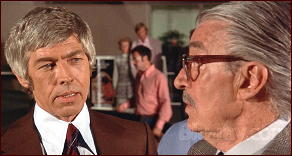
With a prominent score by Lalo Shifrin, one that occasionally overwhelms what’s happening on screen, the film at times seems to be as much a musical as a crime drama. At the end of the day, the movie is best understood as a drama, even a tragedy. It’s a study of human frailty and character flaws, wrapped up in a package with the words “quirky crime film†written in black marker.
The plot. Harry (James Coburn) is a pickpocket, living a luxuriously itinerant life on other people’s money and credit cards. Joining him for the proverbial ride is Casey (Walter Pidgeon), an aging pickpocket with a cocaine habit.
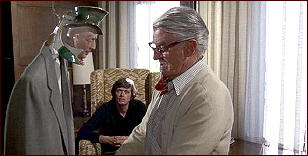
They eventually join forces with Ray (Michael Sarrazin), an ambitious young pickpocket, and his girlfriend Sandy (Trish Van Devere). Soon, however, each of the gang’s personal flaws begins to take a toll on the group’s cohesion. Harry’s too rigid and is a womanizer. Casey has a drug habit and is ashamed that he is no longer as steady on his feet as he used to be. Ray is too ambitious for his own good and becomes increasingly jealous of Harry’s infatuation with Sandy. And Sandy. She’s the linchpin in all this. Even Harry says that he thinks she’s going to be trouble.

While it’s not what I would call an excellent film, Harry in Your Pocket is a quite captivating work. It’s subtle and Coburn puts in a solid performance. It’s Pidgeon, however, in one of his last leading roles, that made the most memorable impression on me. Look for the scene in which he is instructing Ray on the “art†of being a pickpocket. He reminisces about the good old days before mugging, when pickpockets took their craft seriously and there was a code and honor in the “profession.â€
It’s that sense of melancholy and nostalgia that stayed with me. A product of the 1970s, Harry in Your Pocket could be easily interpreted as an extended cinematic metaphor for the generational divide in early 1970s American society.
Sat 15 Jul 2017
Posted by Steve under
Reviews[11] Comments

JOHN RHODE – Dead of the Night. Dodd Mead, hardcover, 1942. Popular Library #99, no date stated [1946]. First published in the UK as Night Exercise, Collins, 1942.
There are not many detective novels written during wartime, and World War II in particular, in which the war effort at home (England, in this case) is such an integral part of the story as it is in Dead of the Night.
The first 60 pages are taken up with a detailed description of a night drill conducted by the local company of the Home Guard set up for the small fictitious town of Wealdhurst. In charge of the mock operation is Major Ledbury, who has his finger on everything, except for the “invading force,” who have orders to act totally by surprise and on their own. Even the women in the town have their jobs to do, manning water pumps and tending to the fallen.
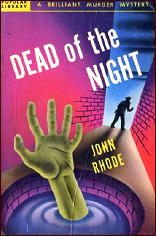
This is fascinating. If scenarios such as this were covered in my high school history classes, I wouldn’t have slept through them.
At the close of the simulated invasion, it turns out that a much disliked Group Commander named Colonel Chalgrove has gone missing. The next 70 pages are spent in wondering where he may have gotten to, with suspicion falling largely on Major Ledbury, especially by the men under his command. Not so much so by Inspector Kilby, who has been put in charge of the case, although he does has to keep an open mind about the matter.
The investigation that follows, as much as I hate to say it, is as dull as dirt, consisting mostly of conversations about reports that have come in to headquarters. It’s talk, talk and more talk, the same limited ground trampled over, over and over. If the reader can’t pinpoint the killer on his or her own 30 pages before the end of the book, he or she simply wasn’t paying attention. Or had snoozed off long before.
Not every relic of the Golden Age is a gem. Not a keeper.
« Previous Page — Next Page »








